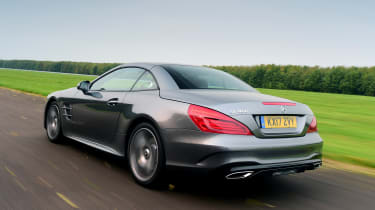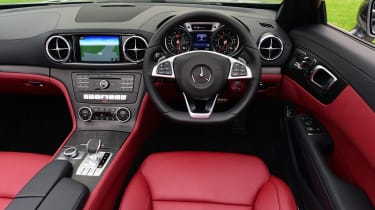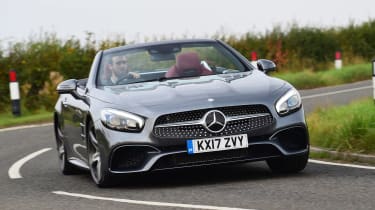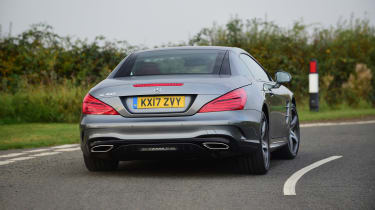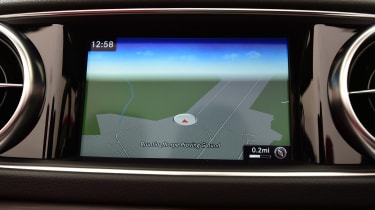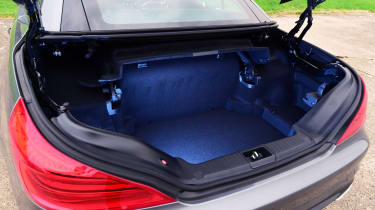Mercedes SL (2012-2020) review
The Mercedes SL is a status symbol that delivers style and performance unlike any other sports car on the road

Mercedes has expanded its range to include all sorts of sports cars, from supercars to hot hatchbacks, but the Mercedes SL is still the epitome of the open-top, two-seat grand tourer. The model has been around for more than 60 years, and the sixth generation model is a clear evolution of previous generations, because it offers luxury motoring in an understated package, while top-spec models are deceptively quick.
The original SL was the 300SL Gullwing, a two-seat coupe with clever doors that were hinged from the roof and opened upwards, a trick later emulated by the SLS supercar. This car had the in-house model code W198, and was built from 1954 to 1957, when it was replaced by the 300SL Roadster, which was the same car but with a folding fabric roof. This was built from 1957 to 1963.
The W113 SL, known as the Pagoda by enthusiasts thanks to its detachable hard top, arrived in 1963 and continued in production until 1971. It was replaced by the R107, which returned to a fabric roof and remained in production for almost 20 years, only being replaced by the R129 in 1990. This model lasted for over a decade, when it was replaced by the R230 in 2002. The SL evolved by introducing the folding hard-top from the SLK, while official AMG models joined the range, too.
Used - available now

2020 Ford
Focus
17,904 milesManualPetrol1.0L
Cash £14,400
2025 BMW
iX
22,776 milesAutomaticElectric
Cash £38,948
2022 BMW
i3
15,263 milesAutomaticElectric
Cash £18,010
2020 BMW
X4
29,164 milesAutomaticDiesel2.0L
Cash £27,259• Mercedes SL 400 vs Lexus LC 500h
While the R230 went off sale in 2011, we had to wait until 2013 for its replacement, the R231, which is the current sixth generation model. It's very much an evolution of the last model, with a folding hard top and lighter construction helping to boost performance and efficiency. AMG models formed the bulk of the range, while an update in 2017 saw new engine and gearbox combinations added to the line-up.
At the top of the range, the AMG models, the V8 twin-turbo SL 63 and V12 twin-turbo SL 65 have price tags in excess of £100,000, but they deliver huge performance in a relatively subtle package when compared to models such as the Ferrari California/Portofino and Jaguar F-Type. Really, the price difference between the V8 and V12 models is so vast, yet the performance is only marginally wider, that we'd recommend the SL 63 over the SL 65 every time.
Towards the end of its production life, the SL range has been pared back to a single model, the SL 400, which features a 362bhp twin-turbo V6 and Merc's latest 9G-Tronic auto gearbox, and is priced at around £78,000.
Other rivals for the SL include the equally ageing Maserati GranCabrio, while the Porsche 911 Cabriolet is a sportier option, although it manages to deliver a comfortable drive if you're taking things easy. The Lexus LC is a thoroughly modern grand touring coupe that makes up for its lack of open-top driving thrills with a futuristic design and advanced tech on board. If you're looking at the most expensive SL models, then you might want to consider cars such as the Bentley Continental GTC and Aston Martin DB11 Volante, too.
And thanks to Mercedes' ever-expanfing range of cars, there are in-house rivals to the SL. If you need four seats, then the E-Class and S-Class Cabrios are available, while the AMG GT Roadster is a more focused two-seat sports car with a folding fabric roof which arguably has better looks.
Many models come and go, but the Mercedes SL has stood the test of time – first appearing as the fixed-roof 300 SL back in 1954. Since then, there's been six generations of the venerable roadster, with the latest version arriving in 2012 before being facelifted four years later.
Few cars at any price can match the breadth of talents you get in a Mercedes SL. The elegant drop-top offers supercar levels of straight-line speed matched with the superb refinement and safety technology you’d expect from a luxury saloon. It's not the finest handling car money can buy, but the muscular range of engines mean there's still fun to be had.
It treads the line between being a full-fat sports car and luxury GT cruiser but is able to play both parts convincingly. The SL perhaps doesn't have the drama of a Jaguar F-Type Convertible but it sounds great, looks good and is rather practical considering its purpose.
Engines, performance and drive
The large V8 petrol engine in the SL 500 is blisteringly quick, accelerating from 0-62mph in 4.3 seconds and up to an electronically limited top speed of 155mph. Opt for the Mercedes-AMG tweaked SL 63 or SL 65 models and acceleration reaches supercar levels, although the handling is still more suited to cruising than lapping a race track.
A naturally aspirated SL 350 was offered in the range until mid-2014, when the twin-turbocharged SL 400 model replaced it. This new entry-level option has 362bhp and costs exactly the same as before. It's a definite improvement over the 350, offering the kind of effortless performance you expect from an SL despite the six-cylinder powertrain.
You feel the dynamic compromise of the folding hard-top set-up, because the SL isn’t sharp to respond to your inputs, while the firm ride even in the adaptive dampers’ comfort setting means big bumps send a quiver through the structure as the SL wobbles and loses some composure.
It’s pleasant on the motorway and a flowing road at a more leisurely pace, though, and with the roof down, gives you even better access to the SL's exhaust note, whichever version you're driving.
The driving position is very comfortable and offers plenty of adjustment. Visibility is also surprisingly good whether the roof is up or down, but the electronically controlled wind deflector can obstruct the rear view when raised.
The car is much lighter than before and features a 57mm increase in track. This really improves handling, and although the SL can’t quite match a Porsche 911 on a twisty road, it isn’t a million miles off.
The Mercedes Dynamic Select lets you pick from a menu of Comfort, Sport, Sport+, Individual, and Eco modes. But there’s also an optional Curve control system that lets the active dampers tilt the car fractionally in corners to improve ride comfort.
In Comfort, the SL is more refined and comfortable than a roadster has any right to be. Even with the roof down, engine and tyre noise is extremely well supressed. Select Sport mode and everything becomes more immediate. Opt for one of the AMG models and you'll notice the engine rumble away in the background, while steering weight increases and the responses of the throttle and gearbox sharpen. Sport+ is another level with more leeway in the stability control system as the SL powers out of corners but the ride becomes harsh on all but the smoothest surfaces.
Even in its sportiest setting the SL doesn’t change direction with the nimbleness of a Porsche 911 or an F-Type. There’s always the feeling that you’re leaning on the electronic trickery rather than the talents of the chassis but the end result is undeniably impressive.
Engines
In terms of 'on-paper' performance, there isn’t a huge amount to choose between the four twin-turbo Mercedes SL engines. The SL 400 will get to 62mph in 4.9s, then it’s 4.3s for the SL 500, 4.1s for the Mercedes-AMG SL 63 and 4.0s flat for the V12 SL 65. All are limited to 155mph.
The justification for the sizable £100,000 price increase from SL 400 to SL 65 lies in the power and torque on offer. Where the SL 400 has 362bhp and 500Nm, the V8 SL 500 ups this to 449bhp and 700Nm. Beyond that, the Mercedes-AMG magic touch gives the SL 63 577bhp and 900Nm, while the SL 65 gets 621bhp and a nice round 1,000Nm. Enough to pull a house down.
You’re paying for the massive extra flexibility these power and torque increments offer and the potential to hit top speeds on the far side of the 180mph barrier when the speed limiter is disengaged and track conditions allow. Plenty of SL buyers will see that as money well spent.
MPG, CO2 and Running Costs
There’s no hiding from the fact that the Mercedes SL is an expensive buy, and this statement even holds up in light of its costly rivals. When you look at its fuel consumption, it’s enough to make a Toyota Prius driver faint.
In its most efficient set-up, with a 3.0-litre twin-turbo V6 petrol engine, it barely returns 37mpg, however this is a massive 30 per cent improvement on the previous model. The SL 500 manages 31mpg on the combined cycle but we only achieved 24mpg on our 350-mile test drive. At the top of the range, the official figures for the SL 65 are 23.7mpg and 279g/km.
In short, running costs can be expected to be high and tax bills will also sting. However, it's no more expensive than a BMW 6 Series and buyers in this market will be prepared for some hefty bills.
Insurance groups
Unsurprisingly, all SL models sit in insurance group 50 because of their price and performance – even the entry-level SL 400 commands top dollar. Again though, if you're buying a car in this sector of the market, that's to be expected.
Depreciation
Despite the high list price, the Mercedes SL will hold on to a decent chuck of its value after three years and 36,000 miles. The basic SL 400 will keep 50 per cent of its original purchase price, while a range-topping SL 65 retains 51 per cent. An SL 500 and SL 63 will hold on to 48 and 49 per cent respectively.
For comparison, a Porsche 911 is about the same, with numbers ranging from 42 per cent to 51 per cent depending on model. A Jaguar F-Type sits in the same ballpark, though a flagship SVR version will suffer the most – retaining just 35 per cent of its value after three years.
Interior, design and technology
The sixth-generation Mercedes SL has quite a bit to live up to. Over the years the SL design has evolved rather than been reinvented, and the 2016 version features a smoother design that stays true to the original. A long bonnet and small cabin mimics the traditional roadster and it looks far more menacing than it did before the latest facelift.
There’s a far more aggressive front end on the latest car with more defined front and rear bumpers along with new alloy wheel designs. The Mercedes-AMG models also feature unique 'Bi-turbo' badges on the flanks.
In the cabin, the Stuttgart manufacturer lives up to its heritage, by tastefully blending fine leather, metal trim and aero-inspired instruments to create a feeling of grandeur. It now incorporates Apple CarPlay technology, too, allowing easy smartphone integration on the move.
Sat-nav, stereo and infotainment
As the latest SL is just a facelift of the old car, Merc hasn't fitted the mouse-like controller for the Command Online infotainment system found on other more modern models. Instead its sticks with the old swivel wheel found in dated cars like the SLC (nee SLK). It's still easy enough to use and quite responsive. There’s also Apple CarPlay integration and a mind-boggling array of other features.
The colour display is bright but the graphics do look a little dated compared to the new systems you find in BMW and Audi models. However, it is nicely integrated into the dash rather than perched on the top, so makes the cabin look a lot better packaged.
Practicality, comfort and boot space
When you think about the Mercedes SL, forget the need for four seats, non-mark materials and useful things like resistant plastic bumpers to squeeze into a parking slot.
The SL instead focuses on giving driver and passenger ample room inside the cabin, while the boot - which has 350 litres with the lid down - is more than big enough for a couple of small suitcases. Parking sensors are standard and to get the most out of the British summer, the hard roof comes off in 20 seconds.
As standard you get a driving position with a wide range of adjustment and seats that are shaped for comfort rather than vice-like side support. Our AMG Line model, however, added the £1,725 Active Multi-Contour Seat package with its active side bolsters that prop you up during hard cornering and a massage function with seven modes to help the miles fly by.
Leg room, head room & passenger space
The SL is more of a GT cruiser than a sports car, therefore, it has the classic long bonnet and cab-rearward design but it is a strict two-seater. With the roof in place there is a good amount of headroom for both passengers, with enough space for the tallest of adults to stretch out, too.
Boot
For a two-seat roadster the SL is rather practical. With the roof in place the boot measures in at 500 litres, but even with it stowed there's still 350 litres of space. Loading items isn't an issue either as a tilt function lifts the roof by 25 degrees when it’s stowed in the boot to help you get your luggage in.
Reliability and Safety
The Mercedes SL hasn’t been tested by Euro NCAP, but thanks to a large array of airbags and electronic safety features, as well as the German brand’s excellent reputation, potential buyers can be sure it will rate five stars for safety.
It's brimming with driver aids such as adaptive braking, stability control, anti-skid mechanisms and traction control, and it also includes a system that detects when the driver is feeling tired. Older versions of the SL developed a few electrical gremlins after a few years, but this new model seems to be holding up very well.
Mercedes finished just outside of the top 10 manufacturers in the 2016 Driver Power survey, finishing in 12th place after an 11th place finish in 2015. Although not the best position to be in, Mercedes will be pleased to hear it finished ahead of rivals BMW and Audi, but Jaguar was ahead in 6th place.
Warranty
The Mercedes SL comes with a three-year/100,000-mile warranty that’s fairly standard in the industry. There’s also up to 30 years’ cover against corrosion and Mercedes-Benz Roadside Assistance which includes up to 30 years of breakdown cover across Europe.
Servicing
Depending on the age or mileage of your SL, Mercedes will carry out an ‘A’ or a more comprehensive ‘B’ service. There’s also the option of Mercedes Service Care which splits servicing costs into manageable monthly payments but you wonder how many SL owners will need to take up that option.
More reviews
Car group tests
In-depth reviews
Road tests
Used car tests
Which Is Best
Most Economical
- NameMaybach SL 680 Monogram Series 2dr Auto
- Gearbox typeSemi-auto
- RRP£239,205

